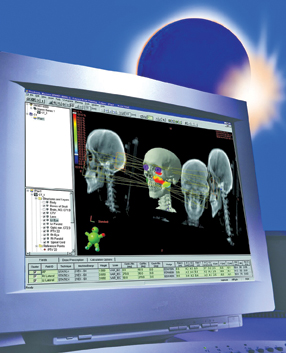
Varian offers the Eclipse treatment planning system.
With the precision afforded by today’s radiation therapy delivery systems, treatment planning software that helps direct the process must keep pace. The treatment planning system provides a 3-D view of the tumor that facilitates decisions about treatment options and helps the clinical team develop the best possible plan. They are a means to achieving the end goal for the patient — perfectly targeted, appropriate dose.
Computed tomography (CT) images are at the heart of most treatment planning, according to recent research by IMV Medical Information Division.1 The IMV report says 98 percent of treatment plans use CT images, 12 percent use magnetic resonance (MR) images and 12 percent use positron emission tomography (PET) images. The report notes that the use of CT for simulation has displaced X-ray simulators; CT simulators represent nearly three-quarters of the current simulator installed base.
The challenge, as treatment delivery and planning become more complex, is to make the process as efficient as possible and maintain a desirable level of productivity. Developers of treatment planning systems are striving to reduce the time it takes to do a plan, even for complex techniques like intensity modulated radiation therapy (IMRT), volumetric modulated arc therapy (VMAT) and stereotactic radiosurgery (SRS). Since usage of these techniques is likely to grow in the future, gaining efficiencies will continue to be important.
As an example, neurosurgeon Jason Andrew Weaver, M.D., talked about the use of SRS in his field, saying, “The ability to treat a vertebral body tumor using stereotactic radiosurgery has drastically changed the field of spinal oncology. We can use stereotactic radiosurgery to treat many spinal tumors that would otherwise have required an invasive operation.”
Weaver, who is with the Semmes Murphey Neurologic and Spine Institute in Memphis, Tenn., conducted a workshop on image-guided radiosurgery at the recent annual meeting of the American Association of Neurological Surgeons. He demonstrated the use of Varian’s Eclipse treatment planning software at the workshop.
In England, where St. James University Hospital uses Elekta’s Monaco treatment planning system for VMAT, clinicians have been able to reduce planning times, facilitating use of this therapy for more patients.
“Our referral rate for radiation therapy is expanding by more than 7 percent annually,” said Vivian Cosgrove, Ph.D., head of radiotherapy physics. “We see VMAT as a key way to manage that growth. If we can plan complex radiotherapy quickly and deliver treatment more efficiently with VMAT, then we can treat more patients and derive more benefit from our existing fleet of treatment machines.”
New Features, Systems
Since the beginning of the year, there have been a few new features introduced, as follows:
• In January, Varian received U.S. Food and Drug Administration (FDA) 501(k) clearance for a new tool designed to work with its Eclipse treatment planning software to reduce the amount of time needed for contouring when planning advanced treatments. It combines two techniques: Smart Segmentation analyzes anatomical images, drawing on information about human anatomy to identify and outline organs and other structures; and Knowledge-Based Contouring, which allows the clinician to start the planning process by drawing on a library of pre-contoured images that have important anatomical structures already outlined. The clinician follows a special process for matching the pre-contoured images with those of the patient to create the desired contours.This can be used to create treatment plans for external beam or brachytherapy treatments.
• Also in January, RaySearch Laboratories’ version 2.5 RayStation treatment planning system was released for clinical use in Europe and the United States. It includes optimization algorithms for VMAT, IMRT and 3-D conformal radiation therapy (CRT). It features improvements to the multi-criteria optimization (MCO) tool that lets the clinician evaluate the impact of changing different treatment priorities in real-time, which can speed up the treatment planning optimization process.
• At the recent European Society for Radiotherapy and Oncology (ESTRO) show, Philips Healthcare introduced its Pinnacle³ auto-segmentation with SPICE, a software module that provides automatic quality segmentations through probabilistic image contouring of the target and critical structures. SPICE uses a new probabilistic technique that allows for the variability of anatomy based on tissue type; faster results are achieved using a sampling algorithm designed to automate and standardize contouring. These features produce contours quickly that usually require little or no editing, reducing interventions by the physician and providing a more consistent contouring.
Reference:
1 2011 Radiation Therapy Market Summary Report, IMV Medical Information Division, http://bit.ly/imvReport


 December 11, 2025
December 11, 2025 









